Sex, drugs and Lima beans.
Anybody care to guess how I’m going to squeeze all that into this post?
* * *
Normally for group tours, there’s a welcome meeting the first night where the tour group meets each other and the guide sets the ground rules.
Not this time. As many of the travelers were flying in late that first day, we simply gathered in the lobby of the hotel the second morning and hit the ground running. First stop, the 17th-century Monastery of San Francisco complex.
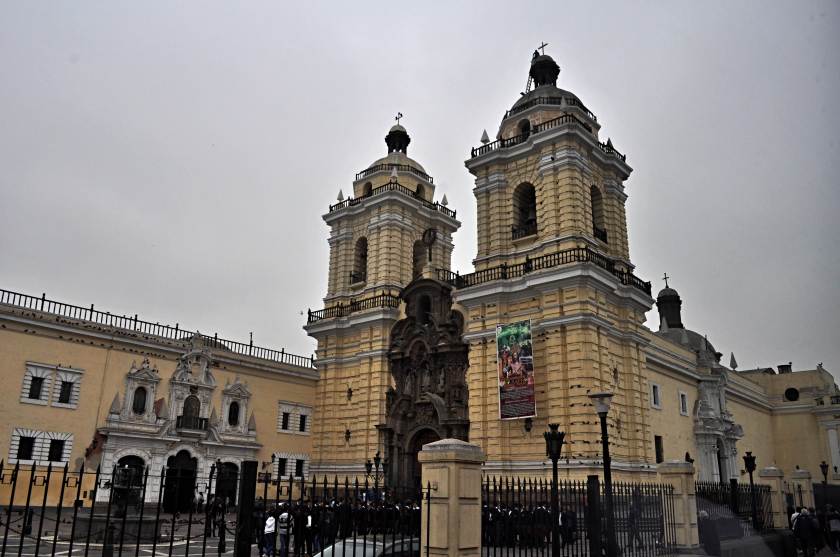 Entering the compound we were met with signs and waving fingers – NO PICTURES! So I can’t show you the elegance of the church, or exquisite wooden seats carved into walls of the choir loft, or the huge ancient songbooks set upon stands in that loft – big enough for aged monks sitting 30 feet away to read. I can’t show you the library with 25,000 volumes, many of which go back to the 17th century or earlier. I can’t show you the courtyard surrounded by cloisters, the walls covered with artistic old tile, paintings above, with ceilings of ornate carved wood panels. As for the old ladies sitting in the courtyard, scrubbing and restoring tiles, forget it.
Entering the compound we were met with signs and waving fingers – NO PICTURES! So I can’t show you the elegance of the church, or exquisite wooden seats carved into walls of the choir loft, or the huge ancient songbooks set upon stands in that loft – big enough for aged monks sitting 30 feet away to read. I can’t show you the library with 25,000 volumes, many of which go back to the 17th century or earlier. I can’t show you the courtyard surrounded by cloisters, the walls covered with artistic old tile, paintings above, with ceilings of ornate carved wood panels. As for the old ladies sitting in the courtyard, scrubbing and restoring tiles, forget it.
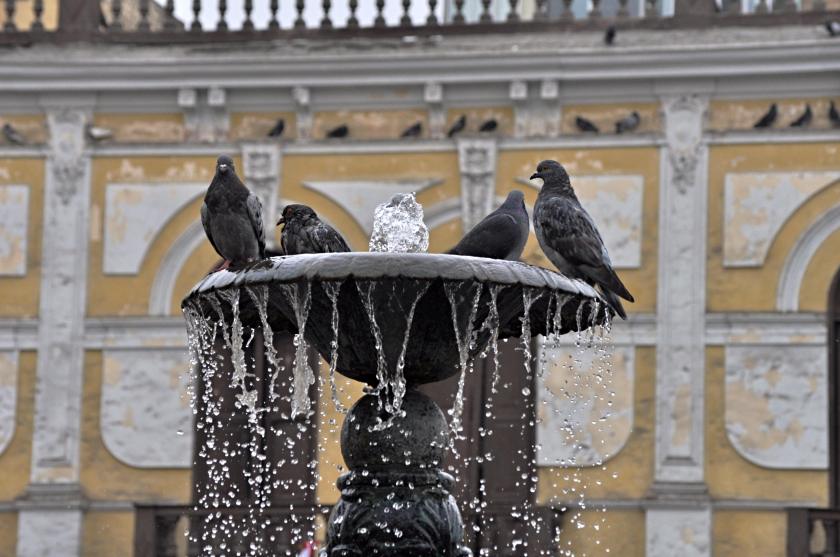
Maybe you wouldn’t choose to see the cemetery under the church. No church side burial six feet under in caskets this – it’s just a collection of bones. They’d bury them in pits, stacked up and covered in dirt and quicklime, where the bodies would decompose to skeletons. In the early days anyone could be “buried” under the church with the understanding of what would happen to their body. In time it began to fill up and only the brothers would be buried there.
At some point, things got a tad crowded (30,000 skeletons in your closet will do that) and the bros did a reorg. As in, femurs in one section, tibias in another, skulls in another, ribs somewhere else – you get the picture. If not, check this. A walk through the bricked in catacombs will show some of those pits, complete with dusty bones, nicely organized and stacked.
A couple blocks from the monastery is the Plaza Mayor, the old city main square. This is where the Spanish powers of the day hung out, and the buildings reflect it.
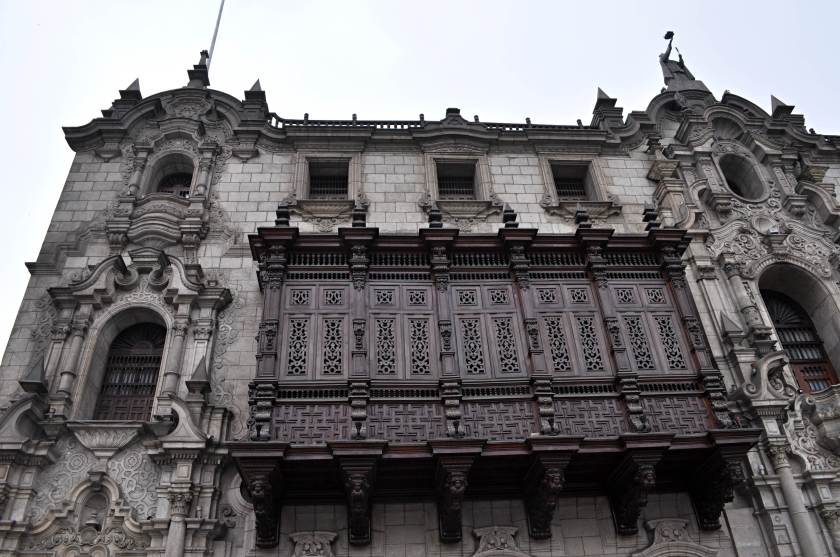
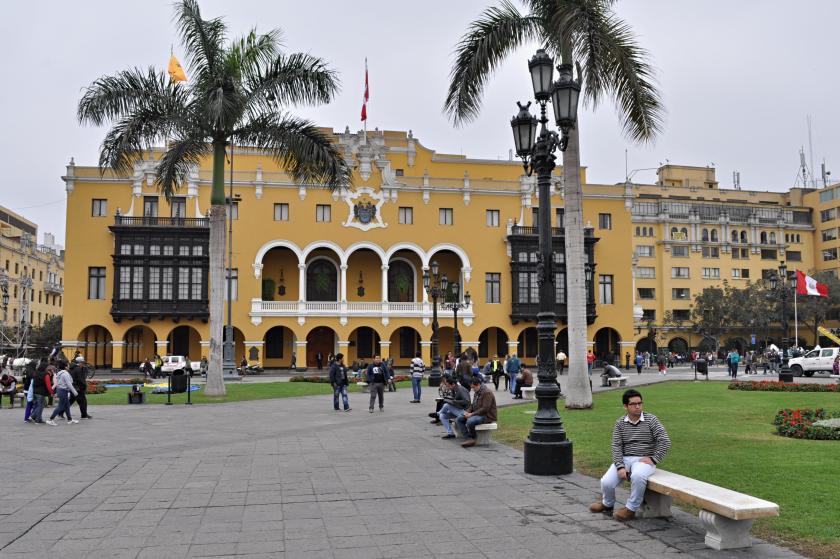

After lunch, the next stop was the Larco Museum. The Larco is a private museum, established by Larco Hoyle and opened in 1926. Larco picked up a substantial number of artifacts from various sources, including “clandestine excavators.” I suppose it’s better than Larco amassed the collection and made it available to the public than all those artifacts being spread who knows where (which still goes on.)
As for the contents, it was much like going to any museum – so much stuff from so many places and eras, it’s impossible to keep track of it all. It’s fair to say that much of it predates the Inca empire. We’ll let the pictures speak for themselves, and you can wander through the museum virtually. I’ll comment where I can.
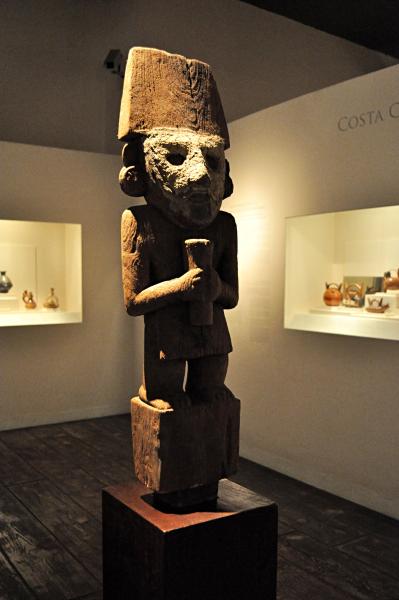
 |
 |
 |
 |
I’ve read that the Inca culture did not show human forms in their ceramics. It seems probable that these pieces are from the Moche culture – a larger contemporary of the Lima, living further north on the coast.
It’s hard to tell from this angle, but the tube coming out of the top of the heads are stirrup-shaped spouts. I’d guess these elaborate works were designed for ritual use rather than day to day use – possibly something like a canteen to be placed in a burial chamber to be taken into the next world. These spouts were common on many forms of ceramics found in the museum.
Besides, can you imagine trying to clean the inside of one of those pots? Seems like a one-time use thing, or maybe limited to water. Archeologists, please weigh in.
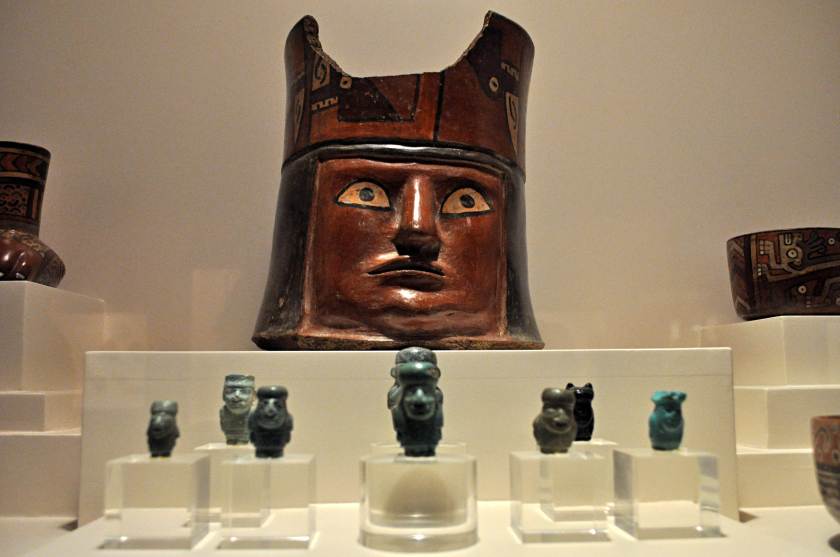

These ancient cultures, despite their longevity, were missing one thing that would seem critical – a writing system. This implies a strong oral tradition for passing on knowledge. The only thing that suggests record keeping is the quipu.
The quipu is a series of strings of various lengths and colors, each with a knot or knots of different types and sizes in different places. This appears to be a mnemonic for recording different things: maybe crop yields, maybe populations, maybe the number of skulls whacked by the local warrior hero. Nobody knows the code, but they’re working on it. This is made more complicated as the Spanish conquistadors destroyed many of them, thinking either they were elaborate evil webs of Satan, or maybe they thought it would disrupt local administration.
 |
 |
Speaking of warrior heroes, I learned nothing of old time armies. But these artifacts suggest archers, spearmen, and infantry supplied with war clubs – club heads being anything from a clump of wood to these more ornate carved stone heads. Perhaps these fancier clubs were used for ritual combat. It didn’t pay to lose and not be killed outright, losing warriors could be grist for human sacrifice.
 |
 |
| Adornments for a Chimú Priest, King, or maybe both. | Ceremonial Knife and Cup to Collect Blood |
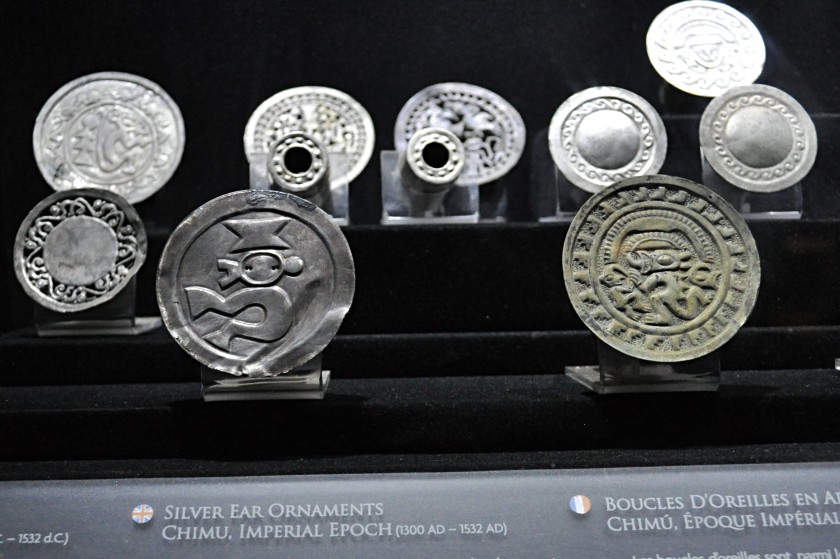

The items on display were just a small fraction of the collection. Consider these sample shots from a storage building…
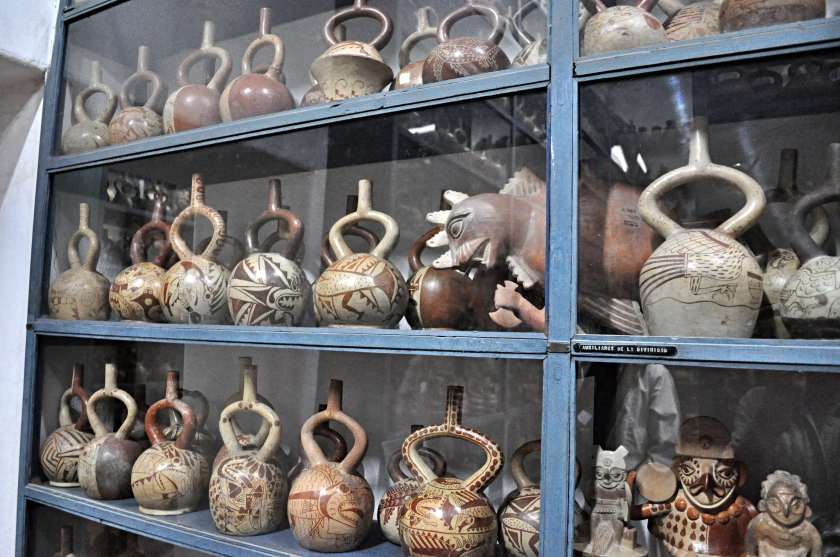

The grounds of the Larco are set within an old homestead, large, with impressive buildings and grounds. And since I like flowers…
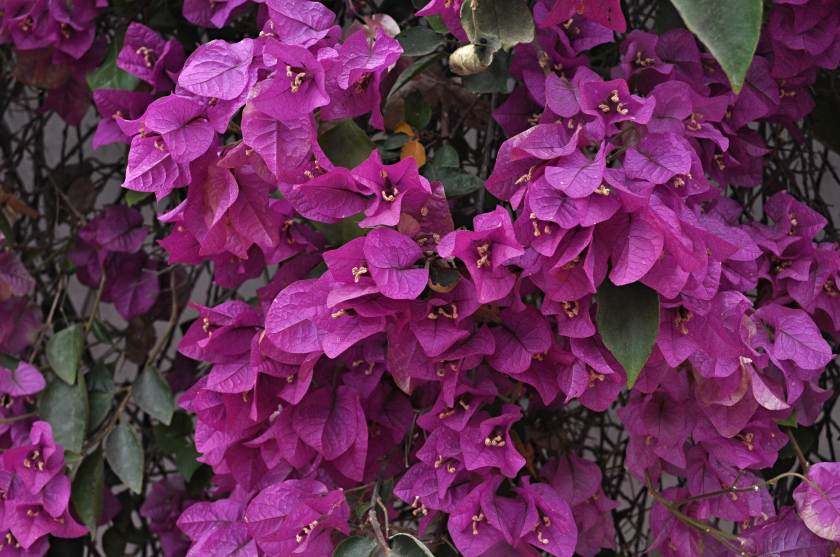

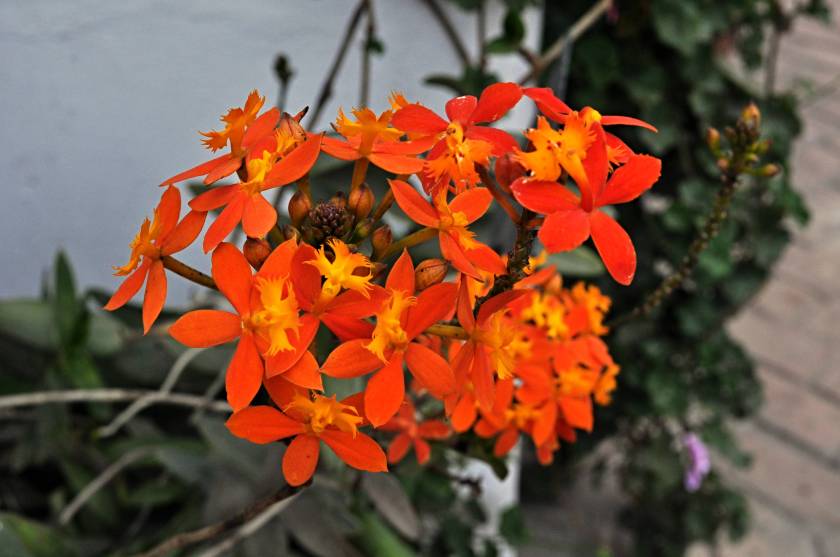
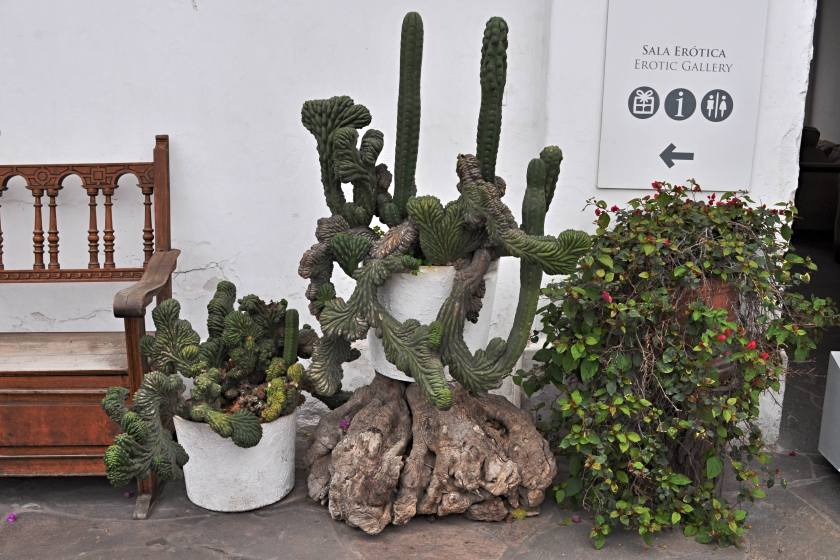
I promised drugs. While I thought the cactus with all the strange shapes was mind-bending, it’s the tall columnar cactus in the middle that packs a punch.
San Pedro’s cactus has a long history of being used in Andean traditional medicine. Archeological studies have found evidence of use going back two thousand years, to Moche culture. The cactus contains several alkaloids, most notably the psychedelic drug mescaline. Although Roman Catholic church authorities attempted to suppress its use they failed, possibly in part due to the natives naming it after the Catholic’s second favorite saint – Peter. The excuse? The cactus allows users “to reach heaven while still on earth.”
Did you wade through all this dry history to see what I’d have to say about sex? Note the sign to the upper right of the cactus; erotic gallery. This turned out to be ceramics of figures in sexual positions.
This puts me in a dilemma. I have several pictures from this gallery, ranging from “that’s explicit” to “Oh My God!” What to show in polite company?
Oh, the heck with it. This is all academic, right? But you’re entitled to a few OMG’s just the same. The following is not suitable for work, children, etc.
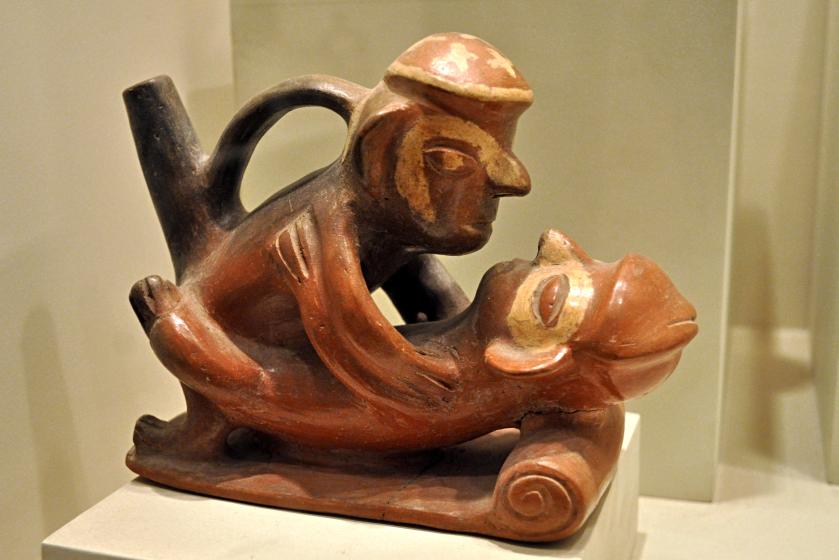
There were many variations on this, most of which suggested the missionaries hadn’t been around to suggest the “proper” way to do it.
 |
 |
| OMG! | |
Shocked? Stunned? Forget about the Lima beans?
After having our minds blown at the Larco we retired to the hotel. This was followed by a short rest where we decided what to remember and what to try to unsee, then, finally the Welcome meeting. The main topic of interest was how to avoid altitude sickness, as the next day we were off to the highlands (minimum 8,000 feet or 2,500 meters altitude.) Hydration was the answer; our assignment, drink two liters of water before 9 AM the next morning. Then, off to dinner.
Dinner was banquet style: an assortment of different dishes including uses for six various kinds of potatoes. Yeah. Spuds. Peru has hundreds of kinds of potatoes, we must have tried a dozen before we left. And yes, there were lima beans.
Everyone has types of food they hate. For me, lima beans are high on that list. Growing up my Mom would try to sneak them in from time to time because they were healthy, but ugh! Plump little bundles of mealy, ashy, bland but awful flavors; when hidden in mixed vegetables it was like hitting repulsive little land mines for the tongue. Would the “real” thing be better, much as fresh or frozen peas are better than canned peas?
Lima beans from Lima turned out to be bigger, flatter, and denser. The flavor was more pronounced. Overall, not great, but eatable.
BTW, our guide instructs, “they’re not lima (pronounced lime-a) beans, they’re lima (pronounced like the city name) beans.”
There you have it. Sex, drugs, and lima beans. Skeletons in a closet. Ancient civilizations. Pottery with drinking handles. Encoded Peruvian mnemonics. Priests and mummies, utensils of sacrifice.
And you thought Lima would be the boring stop.


A great post! It brought back a lot of memories.
LikeLiked by 2 people
I suspect I’m just starting to repave memory lane for you. 🙂
LikeLiked by 2 people
I love the Larco Museum. Thanks for this great post.
LikeLiked by 1 person
Sometimes museums are kind of boring, or just overwhelming. This one was interesting, and just the right size.
LikeLiked by 1 person
Excellent post, thanks for sharing with us. Such a shame you couldn’t provide photos for the monastery description, I bet it was interesting given your written tour. Museums of other cultures hold fascination once you get past a certain age..I’m there, very interesting. Sex and drugs, well, always interesting and Lima beans are probably best avoided once past a certain age!
LikeLiked by 1 person
I couldn’t do pictures, but these folks got some of it.
And yes, now that I’m back from Peru I’ll probably go back into lima bean avoidance mode.
LikeLike
Haha! Great tale, Dave! Very inspired. 😉 I can’t believe the organization involved with the bones. And my husband thinks I’M a neat freak with OCD tendencies. Wow!
LikeLiked by 1 person
Well, I expect the monks had a fair amount of spare time on their hands. If your day job is praying, might as well pray over organizing bones.
Incidentally, the guide mentioned some folks have a tendency to take a souvenir skull. The idea being, the soul of the deceased would protect your house, with the only caveat being you’d have to light a candle and pray for the soul periodically. If you didn’t pray for it, the soul would haunt you and give you bad luck.
LikeLiked by 1 person
Yes, I think I’d haunt someone if they stole my skull and didn’t at least have the courtesy to pray for my soul.
LikeLiked by 1 person
Oh, I never thought the Lima post would be boring. It’s over thirty years since I was there and i think I still have the hangover (or one of them, anyway).
Great to see so many things I didn’t get to see, though.
LikeLiked by 1 person
Pisco sours? Or some other sort of hangover? I didn’t do much beyond a little sampling.
LikeLiked by 1 person
Oh, pisco sours definitely. I suspect they took about ten years off of my life expectancy. I was there for six weeks and I’m afraid i got through rather a lot!
LikeLiked by 1 person
An interesting title for sure, but an even more interesting post! Anyone can make sex and drugs interesting, but lima beans? Now that takes a true writer! Seriously, it was very informative. I doubt that I will ever make it to Peru, so reading about it is the next best thing. Thanks!
LikeLiked by 1 person
🙂 I suspect the phrase “Sex, Drugs, and Lima Beans” is not one that comes up in your typical conversation, but hey, gotta make a trip to museums interesting somehow, right?
LikeLiked by 1 person
Hi, Dave. It’s a shame we won’t be spending much time in Lima other than taking a gourmet food tour. It seems there’s more to Lima than I imagined. We will have been gone for a little over three weeks and seen a lot of Peru. I imagine by the time we get to Lima to head home, we will be pretty tired. Very interesting post.
LikeLiked by 1 person
At three weeks I’m sure you’ve seen far more of Peru than us, so even if you didn’t get a lot of time in Lima you probably experienced more unique things than we did. Memorable, any way you slice it.
LikeLike
Great post, Dave! You have made Lima (in my opinion, definitely a little boring, especially in relation to its baby sister, Cusco, and all the relatives in the Sacred Valley) a lot more interesting! In my times there, I have not seen the Larco Museum. How did it compare with the Gold Museum (if you went)? I also now have an idea where the whole Larcomar area got its name. I learned many other new things here, but I’ll start with the last: I had no idea that wretched vegetable hailed from Peru. If I could pick one of the last things on earth I’d choose to eat, a Lima bean would be one of them. As for the sex carvings, you should see the stuff in some of the Buddhist temples in Tibet and Mongolia! Somehow, religion and tantric sex don’t go together (so to speak) in my mind, but apparently that connection is long-lived in many cultures around the world. A little disturbing in my view. Anyway, loved your ramble around Lima today – can’t wait to get out into the valley and mountains, though!
LikeLiked by 1 person
We didn’t make it to the Gold Museum, so I can’t compare.
It is interesting the wide variations on how religions approach sex. Seems like it’s one extreme or the other. No wonder people are so screwed up about it.
One more quick story from Lima, then we’re off to the highlands. I fear when it comes to Cuzco I may be a bit limited on touring tales, but that’s another story…
LikeLiked by 1 person
Oh, no – hope it wasn’t the altitude …. I’ll be patient and wait!
LikeLiked by 1 person
You really made Lima beans come alive for me in this one, Dave!
LikeLiked by 1 person
There’s an image for you – crazy scientists lab, big lima bean on the table, bzzzt, IT’S ALIVE! Scary. 😉
LikeLike
I greatly enjoyed your post with the femurs in Lima. Lots of terrific pics as always.
As for the erotic museum, one imagines the potters of the day must have been munching on mescalin to come up with those characters. Either that or the plastic surgery industry is a lot older than we suspected..
LikeLiked by 1 person
For some reason, I read “femurs in Lima” and came up with lemurs. Maybe it’s related to what they’re seeing behind their OMG expression…
LikeLiked by 1 person
Love the Erotic Gallery! Very cool. We’re all adults here. I say share it all.
As for Lima beans, I always thought I hated them. Then a few years ago I tried them again for the first time since I was a kid…and found them surprisingly not awful. I guess it’s true what they say about your palate maturing as you get older.
Looks like a great trip!
LikeLiked by 1 person
I suspect I’d still be spitting them out like a Gatling gun if I had to eat the canned version.
LikeLike
Ah, Peru, one of my favorite places. The culture and artifacts from the moche and Inca are amazing. As for the pots, I think some were used exclusively for burials while others carried water and other liquids. It brings back memories of my trips there and my undergraduate studies in archaeology.
LikeLiked by 1 person
I can see where Peru would be an even more interesting place if you were studying archaeology. The Inca get all the press, but so much predates them – what was really going on?
LikeLiked by 1 person
Olá,
Podemos usar uma foto que está nessa reportagem?
obrigada,
LikeLike